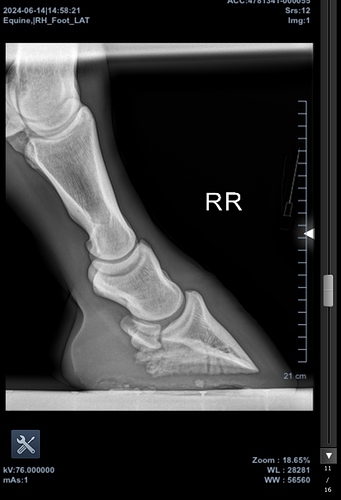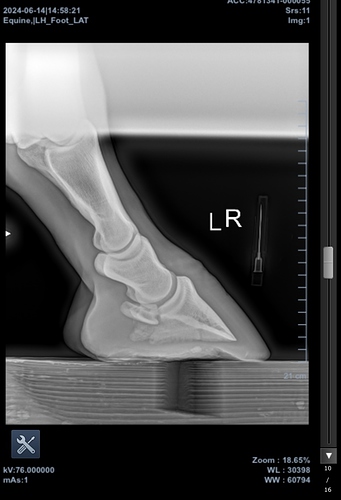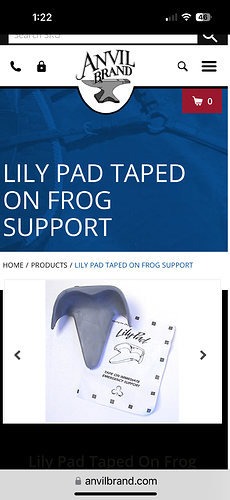Just so you know, Thyro-L is used a lot for the metabolic horses, but it has zero effect on insulin levels. It can help get weight off and clear triglycerides from the blood during the weight loss. But no change in insulin if you are dealing with a hyperinsulin issues. That is where the metformin and -gliflozin drugs come in. And also for the horses who are ID without being overweight.
Here are the hinds I posted upthread but this post got long!
The blocks would be easy to do and are a good idea. I have reached out to another farrier that’s willing to help but I have to haul in. Seems most of the good ones are doing haul in only these days.
After learning the first radiograph is because of the block she’s on, I agree it may be a mechanical laminitis or really bruised soles or even a bruised coffin bone. Is she sensitive to hoof testers? We had one TB w absolutely terrible feet and really lame. His coffin bone lit up on a bone scan to the point they looked for a fracture on a radiograph. No fracture. Our farrier (we are fortunate to have a superb farrier) shod him w a leather pad. It took 3 shoeing cycles to resolve, but it did. To improve the feet, we fed additional copper and zinc, along w biotin. We also turned this horse out in soft, cheap gum rubber bell boots.
With respect to the stifle, we had another one w a problem. The vet suggested a topical blister w liniment. That was an epic fail. What did work was a very good body worker who felt it and said the meniscus had slipped out of place, which I’ve never heard of. She did some weird manipulation and he’s been fine ever since. Do you have access to a good body worker?
Centaur 3 D frog support pad.
Here’s the pad our farrier uses for a laminitic horse. Edited to add we’ve not used the taped on frog support one above.
She’s been on copper and zinc and biotin luckily but I ran out of biotin. I’ll get some more. Interesting about the shoes, if I can get her to keep them on I’m not against shoeing but right now she overreaches straight through bell boots.
My 10mm easycare pads should be here today so I’ll put those in her boots. I realized her boots are pretty hard without a pad but not pokey like being bare and stepping on a rock. Hopefully the pads will help while I figure things out.
It looks like what little research is out there shows a pretty poor recovery rate for stifle surgery so the only value for my horse would be in knowing what is going on. I will talk to another vet but I think I’m leaning towards doing non-surgical treatment on her stifle and seeing how her feet respond. I just don’t know what biologic to choose, and am also considering Adequan or something.
Ugh. This is tough and discouraging, but at least she’s bright eyed and happy to see me every day. Especially if I let her crib lol!
Did anyone ultrasound her stifles? I had a vet I think well of tell me radiographs were not particularly helpful as a diagnostic for stifles. Does she have fluid on them?
Yes we ultrasounded! It is a mess with some fluid or inflammation (fibrous? Old healing maybe?) and it’s noisy enough the vet and the school surgeon can’t really tell if it’s the meniscus or the ligament or both.
Oh…I’m sorry I missed/forgot that.
Interesting. In one of my horse’s cases, she was 7, and presented with acute sudden laminitis. It was springtime in Virginia, and we had been going through a particularly lush period. Body condition had gone from a 6 to a 6.5 over the course of a week. She was a super easy keeper, and it was hard to keep weight off, even when getting worked 6 days a week and fed only ration balancer and hay.
Anyway, from what I can remember, she was diagnosed as having insulin dysfunction or disregulation, but was not diagnosed as an IR or EMS horse yet. My vet described it as a continuum, and the thinking was that she had developed metabolic issues that spring because of the pasture situation and some diet factors where I had her boarded. So we made a significant diet and management change, and I brought her back to my home where I could closely manage her and turnout on a dry lot, and worked HARD to get her weight down, while also trying the metabarol supplement. And… eventually I got her down to a BCS of 5, and her levels went back within normal ranges. So we never had to use the Thyro-L to get the weight off.
It was kind of a 2 fold challenge, if that makes sense. I probably didn’t articulate it well in my earlier comment. I might be forgetting some details. But hopefully that makes more sense. The vet did conclude this horse was at increased risk of developing true EMS over her lifetime though, especially if her weight and diet weren’t continually closely managed. She’s since sold, and is doing well, thank goodness. But the whole thing was an educational experience for me.
N=1 and all, but I got great results with ACS on my horse whose IR is now better managed. We did his SI and also do IV weekly (or twice weekly when working hard or showing).
I would want the palmar angles corrected all around before pursing surgery in the stifle if this were my horse. With that said, if this were just a case of thin soles, you could slap pads on the horse and the horse should be quite sound. You could also quickly move the palmar angles in the right direction with a wedged pad. If I personally saw significant improvement with this type of set up, then I’d consider the surgical options with the stifle.
The rads look like pretty classic thin soles to me. Setting aside the wonky image which looks to have been taken at an angle plus with the different block, there’s a little bit of rotation on the LF. Could be from low-grade laminitis due to the thin soles and inflammation; could be poor trim, could be any number of things. I would pad her boots as aggressively as you need to to achieve comfortable movement. What boots are you using? The comfort pads are good, you might need to double them up. You don’t just want slightly better, you want noticeably more comfortable striding with a flat or slightly heel first landing. If you can get someone to video her walking on levelish ground with different pad set ups that would be helpful.
You will need lots of pads to rotate through as they squish down. Comfort pads are great, but more economical options include yoga mats and felt western saddle pads. You may need to switch padding around as she adjusts and grows out. I also agree it’s worth a shot trying some wedge pads behind (do you have boots for her hinds?). Scoot Boot makes a great 2deg wedge pad.
I don’t see anything in these images that makes me think the horse is an imminent founder risk or has catastrophically irreparable feet. They look pretty standard for a fresh OTTB who is barefoot with a farrier/trimmer of middling ability.
I think the stifle is going to be a much tougher fix. I don’t have any advice or experience for that, sadly.
I have Cavallos for her because smartpak carried them and I could return things. I have boots for all four feet so I could definitely experiment with various pad setups, and I am interested in the scoot pads! If I could do something now to test my theory while I work on the other variables I would do it. She’s ouchy on gravel in plain cavallos but I think they’re quite hard without a pad more like a plastic farrier pad with no magic cushion.
I also didn’t think about yoga mats or felt! Anything to save some pennies while I try to figure all of this out would work for me. I did order 10mm and 5mm comfort pads so I can stack those if needed.
Regular farrier said the hinds are fine and to just skip this trim to let her build some sole up front. I’ll rasp the edges some because I know I can do that but I’m just worried about finding someone else to do my horses if that becomes necessary. It seems necessary to me but I could be overreacting or maybe made it seem like I didn’t want to shoe her at all costs?
Also, thrush. Her feet have started to smell even though I pick them daily and take the boots off for at least an hour. Her stall and paddock are dry. I have some white lightning I could soak her with and athletes foot powder I pour in the boots but so many other solutions seem likely to burn or eat away at the good tissue I need her to keep…
I have to say this - you should give Hoof Armor a try. Not only does it put a layer of protection, it helps keep the sole dry. Works really well with getting rid of thrush, too. I have had great luck with it.
Hoof Armor - Abrasive Resistant Hoof Protection Coating - Used Barefoot or with Shoes and Boots
I order it from Valley Vet.
When I’ve dealt with founder I was told to use blue styrofoam insulation to make pads. Easily available at most home improvement stores and pretty cheap.
@knic My thin 2 year old was metabolic after I pulled blood (he is a pony though but I’ve had many of the same breeding with no issues). He was a head scratcher for my vet as he didn’t point to EMS (young age, not overweight, lots of energy, no fat pockets anywhere) but after bloodwork was pulled and he had 2 laminitic episodes after his shots (not on grass, handful of grain and first cut hay), his high insulin was the cause and the shots put him over the edge.
He is now 4 and so far is under control with some slight feed changes and work. He got his rhino/flu IN for the first time that way a few weeks ago and was totally fine (the past 2 times he had that IM shot he had boughts of laminitis).
So don’t count out EMS on a young horse. It can happen, though is rare (we were just that lucky!). Blood work in Ontario was about $500 for the full panel and then just $150 after that for insulin counts which I do every few months to make sure things are on track for right now.
Meant to add his BS is about 5 right now and he was always about that (I’ve owned him since a yearling). He was on metformin for a few months to bring his insulin levels down (did not need thyroid meds as he was not overweight) and now that he is at a good insulin level, I have just stopped the metformin and continued with the dirt paddock, tested hay (5.3%), handful of grain, some supplements, timothy hay cubes, w3 oil and some plain beet pulp to try to keep the weight on him. He has always been a picky eater and hard to get/keep weight on. He eats hay for an hour or so and walks away from it.
That’s why I said unlikely but not impossible. But the posts suggesting she go full bore on EMS diet without testing first were a bit much.
To be fair, anything with pony blood is FAR more inclined to metabolic issues than a TB. That doesn’t rule out a TB, but does make it far less likely to be the root cause without other indicators.
For sure. Totally agree! I was more stating that young horses don’t usually have EMS as it can happen.




